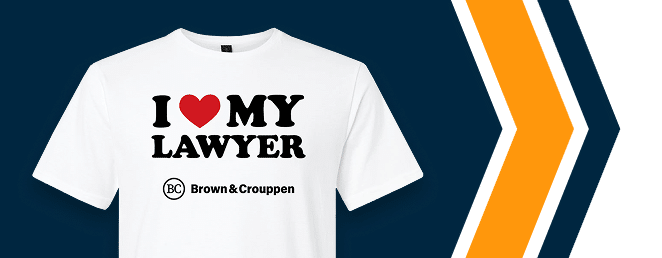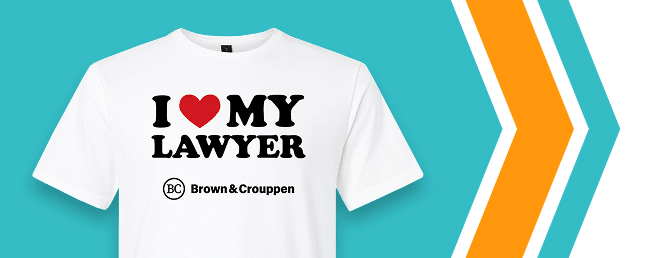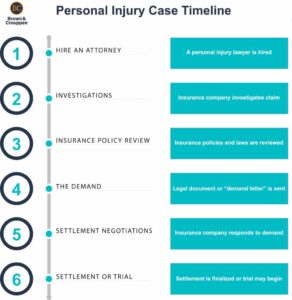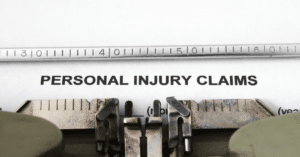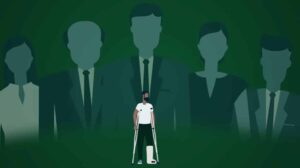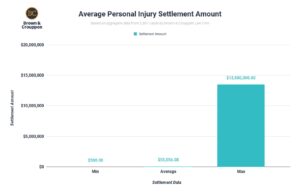Any injury can turn your world upside down. You can quickly become overwhelmed with medical bills, time off work, and the stress navigating your insurance. Having that injury come because of someone else’s negligence can add complication to your injury. Many people assume that filing a personal injury lawsuit will automatically lead to fair compensation, but the reality is far more complex. Winning a personal injury case requires preparation, strategy, and an understanding of both the evidence needed to prove your claim and the law that covers torts, contracts, and civil litigation.
Together we’ll break down the key steps to building a strong personal injury case, including getting medical treatment, preserving evidence, demonstrating negligence, and avoiding common mistakes. By understanding the process, you’ll be in a better position to protect your rights and maximize your recovery.
- Understanding How Personal Injury Claims Work
- Seeing a Doctor and Documenting Your Losses
- Preserving Key Evidence From the Incident
- Demonstrating Negligence and Fault
- Mistakes to Avoid
- How Our Attorneys Can Help You Win Your Case
- Get Help with Your Personal Injury Case from Brown & Crouppen Law Firm
Understanding How Personal Injury Claims Work
At its core, a personal injury claim arises when someone is harmed because of another party’s actions (or even inactions). These cases often involve car accidents, slip/trip and falls, dog bites, workplace injuries, or medical malpractice.
To succeed in any personal injury lawsuit, you must prove four legal elements:
- Duty of care – The defendant had a legal obligation to act reasonably to avoid causing harm.
- Breach of duty – The defendant failed to meet that obligation.
- Causation – The breach directly caused your injury.
- Damages – You suffered measurable losses, such as medical expenses, lost wages, or pain and suffering.
For example, I represented a person injured when they walked up some loose stones steps at an estate sale. There, both the entity that handled the estate sale and the property owners had a duty to the public who were attending the sale and entering the home, to make sure that the premises were safe for attendees. There, they neither attempted to fix the loose stone steps, barricade the steps off to prevent people from using the steps (there were alternative steps available), or post signage warning attendees that the steps were potentially dangerous. They paid a six figure settlement to my client for her injuries.
However, insurance companies, defense attorneys, and sometimes even juries won’t simply take your word for it. You need credible evidence and a clear strategy to connect the dots between the other party’s actions and your injuries.
Seeing a Doctor and Documenting Your Losses
One of the most important steps you can take after an accident is to get necessary medical treatment immediately. Even if you think your injuries are minor, waiting to see a doctor can hurt both your health and your case. Insurance adjusters often argue that delayed treatment means the injuries either weren’t serious or weren’t caused by the accident.
Beyond protecting your well-being, medical treatment creates concrete evidence of your injury. Every doctor’s visit, prescription, physical therapy session, and diagnostic test serves as documentation of your injuries. This record is critical when negotiating with insurance companies or presenting your case in court. While you would have an opportunity to tell a potential jury about your symptoms and how they impact you, only a medical professional can diagnose your condition. Moreover, if the jury does not believe you (or your testimony) for whatever reason, then the medical records stand as proof that the injury exists.
Keeping Track of Financial Losses
You should also document your financial losses. Keep track of:
- Medical bills and receipts
- Lost income and missed workdays
- Out-of-pocket expenses (such as transportation to appointments)
- Long-term costs, like rehabilitation or reduced earning capacity
The more detailed and organized your records are, the harder it is for the defense to dispute your damages.
Alternative Forms of Treatment
Our attorneys have had clients who sought treatment in alternative forms, such as massage therapy (from a friend), counseling from a pastor, hypnosis, acupuncture, and yoga. These are all fine methods of treatment if they help you, but be aware that these forms of treatment often do not come with supporting documentation and you may need to keep track of how frequent you need the treatment and how the treatment impacts you. Beyond that, some potential jurors will not give much weight to these kinds of homeopathic treatments as support for the extent of your injuries. Moreover, all medical conditions must be diagnosed by a licensed medical professional.
Preserving Key Evidence From the Incident
Evidence is the backbone of any personal injury case. Without it, even the strongest story may fail to convince a judge or jury. That’s why preserving evidence from the start is crucial.
Depending on the type of accident, evidence may include:
- Photographs or video of the scene, your injuries, and any property damage
- Police reports or incident reports filed at the time of the accident
- Witness statements from people who saw what happened
- Physical evidence, such as damaged clothing or defective products
If possible, gather this information right away or ask a trusted friend or family member to help. Over time, scenes get cleaned up, memories fade, and crucial details may be lost. An experienced attorney can also send letters to preserve evidence from third parties, such as surveillance footage that might otherwise be erased.
The Dangers of Posting on Social Media
Be aware that evidence can be found on social media sites as well. Attorney Rachel Weinhaus joined a case that was two weeks out from trial. The defense provided pictures of the defendant’s vehicle that didn’t look especially damaged to support their claim that the crash wasn’t “that bad.” However, Weinhaus scrubbed back through five years of the defendant’s public Facebook page to find a post that demonstrated that they only sent us pictures from the defendant’s vehicle after it had been repaired. In fact, the damage to the car was much worse than previously thought.
On the flip side, our attorneys have had clients who claim to be completely debilitated by their injuries, only to post photos of their hiking and hunting trips. While these pictures are only snapshots of their lives (and may have resulted in days or weeks of pain afterwards), they can damage your credibility when it comes to your alleged symptoms.
Demonstrating Negligence and Fault
Winning your case requires more than showing you were injured—it requires proving that someone else was legally responsible. Demonstrating negligence often involves piecing together evidence and expert testimony.
For example, if your injuries were sustained by:
- Car crash: then negligence may be proven with traffic camera footage, cell phone records showing distracted driving, or accident reconstruction experts.
- Slip or Trip and Fall: then maintenance records, employee testimony, or photos of unsafe conditions can establish fault.
- Medical Malpractice: then expert medical witnesses often explain how the provider deviated from accepted standards of care.
Comparative fault laws also play a role. In many states, if you were partially responsible for the accident, your compensation may be reduced. For instance, if you’re found 20% at fault, your recovery could be reduced by that percentage. Demonstrating that the other party bears the majority of responsibility can significantly increase your compensation.
Mistakes to Avoid
Even strong cases can be undermined by simple mistakes. Here are some of the most common mistakes:
- Failing to seek medical treatment quickly and consistently – As mentioned earlier, gaps in care make it harder to prove your injuries.
- Talking to insurance adjusters without legal advice – Adjusters may seem friendly, but their job is to minimize payouts. Anything you say can be used against you.
- Posting on social media – Photos or posts about vacations, workouts, or daily activities can be taken out of context and used to downplay your injuries.
- Missing deadlines – Personal injury claims are subject to statutes of limitations, which vary by state. Missing these deadlines can end your case before it starts.
- Accepting a quick settlement – Insurance companies often make lowball offers in hopes you’ll accept before realizing the full extent of your damages.
Avoiding these pitfalls can make a substantial difference in the outcome of your lawsuit.
How Our Attorneys Can Help You Win Your Case
While you can handle some aspects of a personal injury claim on your own, having an experienced attorney greatly increases your chances of success. Here’s how we can help:
- Investigating your case thoroughly – We gather evidence, interview witnesses, and consult experts to build a compelling argument.
- Handling communications with insurance companies – We protect you from adjusters’ tactics and ensure you don’t accidentally weaken your claim.
- Calculating the true value of your damages – We consider not only current bills but also long-term medical needs, loss of earning capacity, and the impact on your quality of life.
- Negotiating settlements – We fight for a fair outcome and only recommend settlement when it serves your best interests.
- Litigating in court if necessary – If insurers refuse to offer fair compensation, we’re prepared to present your case before a jury.
With the right legal team, you’re not just another file on an insurance company’s desk. You’re someone whose future deserves to be protected.
Get Help with Your Personal Injury Case from Brown & Crouppen Law Firm
If you or a loved one has suffered injuries caused by another’s negligence, you may be eligible to receive financial compensation for lost wages, medical expenses, pain and suffering, and other damages. Getting started is easy. Get help from our legal team by calling us at 888-795-0694 for a free consultation, or get in touch with a Brown & Crouppen attorney by requesting a free case evaluation online. And remember, there’s no upfront cost to you. If you don’t get paid, we don’t get paid.
